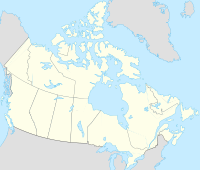Albertonykus
| Albertonykus | ||||||||||||
|---|---|---|---|---|---|---|---|---|---|---|---|---|

Live artistic representation of Albertonykus borealis |
||||||||||||
| Temporal occurrence | ||||||||||||
| Upper Cretaceous (Lower Maastrichtian ) | ||||||||||||
| 72 to 69.9 million years | ||||||||||||
| Locations | ||||||||||||
| Systematics | ||||||||||||
|
||||||||||||
| Scientific name | ||||||||||||
| Albertonykus | ||||||||||||
| Longrich & Currie , 2008 | ||||||||||||
| Art | ||||||||||||
|
Albertonykus is a genus of very small theropod dinosaur from the Upper Cretaceous (early Maastrichtian ) of North America.
The genus assigned to the Alvarezsauridae - a group of probably insectivorous dinosaurs - is so far only known from the Canadian province of Alberta . The only described species ( type species ) Albertonykus borealis is about the size of a domestic chicken and with a tail about 75 centimeters long. This makes it the smallest species of dinosaur discovered in North America to date.
The name Albertonykus is derived from the location Alberta and the Greek onyk for "claw". The second part of the species name, borealis , is derived from the Greek borealis for "north".
Fossil finds and systematics
Alvarez saurids are known only from a few fossil finds in North America . The only Albertonykus find so far comes from the sedimentary rocks of the Horseshoe Canyon Formation, known for its wealth of fossils, near the town of Red Deer in southwest Canada. It is essentially the fore and hind limbs of at least two individuals from the "Albertosaurus Bonebed" (a bone store dominated by fossils of more than 20 individuals of the tyrannosaur Albertosaurus sarcophagus ) in Dry Island Buffalo Jump Provincial Park ; other finds of toe bones come from sites nearby. These fossils were found during an excavation led by Philip J. Currie between 2000 and 2003 and are kept in the Royal Tyrrell Museum of Palaeontology . Here they were identified in 2006 by Nicholas R. Longrich .
A phylogenetic analysis of the fossil material reveals a close relationship ( sister group relationship ) to the Asian Mononykinae . This finding agrees with the hypothesis of an origin of the alvarez dinosaurs in South America, which spread over North America to Asia.
Paleobiology and ecology
Location of the provincial park with the find location in the south of Alberta |
As with other Alvarezsauriden, the short but powerful forelimbs of Albertonykus were adapted to a digging function. However, they were too small for earthworks to be built , so the dinosaur most likely used them to dig insect nests . After analyzing the fossil record of the insects forming the states in question , both ants and termites that build mound nests can be excluded as possible food resources. Ants were hardly present in the ecosystems of the Cretaceous period and termites that built mounds had not yet developed; they did not appear before the Eocene . As a result, only termites that colonize wood are considered for insect predation. Corresponding trace fossils in silicified wood from the Horseshoe Canyon Formation support this hypothesis: In the wood there are often duct systems that are similar to those of the primitive termite family Termopsidae living today .
literature
- Nicholas R. Longrich, Philip J. Currie : Albertonykus borealis, a new alvarezsaur (Dinosauria: Theropoda) from the Early Maastrichtian of Alberta, Canada: implications for the systematics and ecology of the Alvarezsauridae. In: Cretaceous Research. Vol. 30, No. 1, 2009, pp 239-252, doi : 10.1016 / j.cretres.2008.07.005 .
Individual evidence
- ↑ N. Longrich, P. Currie: Albertonykus borealis, a new alvarezsaur (Dinosauria: Theropoda) from the Early Maastrichtian of Alberta, Canada: implications for the systematics and ecology of the Alvarezsauridae. 2009.
- ↑ a b Tiny dino discovered press release (English) from the University of Calgary dated September 23, 2008 including data sheet (PDF file; 1.02 MB)
Web links
- America's smallest dinosaur discovered scinexx.de on October 4th, 2008
- Small dinosaur ate termites at scienceticker.info of 23 September 2008
